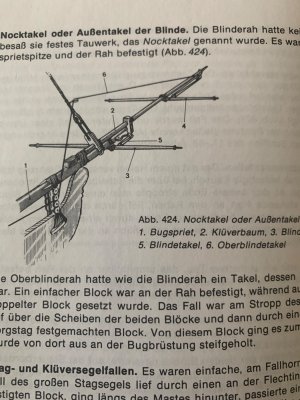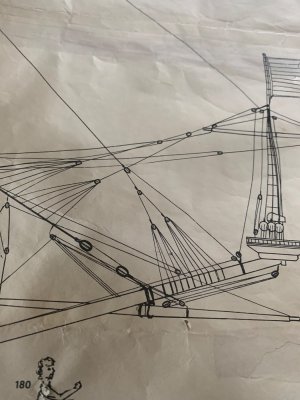-

Win a Free Custom Engraved Brass Coin!!!
As a way to introduce our brass coins to the community, we will raffle off a free coin during the month of August. Follow link ABOVE for instructions for entering.
You are using an out of date browser. It may not display this or other websites correctly.
You should upgrade or use an alternative browser.
You should upgrade or use an alternative browser.
Thanks Dom. When I finished the hull (mostly, anyway) I just assumed the next step would be the rigging. I had no idea the masts and particularly the yards required so much attention and I have been poring over many videos of how best to attach blocks to spars without it looking like a dog's breakfast. It has been slow progress for sure, but I don't mind too much when I consider the sure-fire trials and tribulations of the rigging yet to comeSuper job on the masts so far. It all looks really impressive. Looking forward to seeing the rigging going up - I guess next up will be the main braces and shrouds.

The HMS Fly shipyard has been in sad neglect over the past couple of months on account of numerous other unimportant things, but I do hope to get back on board as soon as possible.
I did however have a chance to sail on the Dutch tall ship Oosterschelde in Sydney Harbour this past weekend. It was a memorable experience and only cost me an outing to a musical with the Admiral the night before
For the history buffs the Oosterschelde is a three-masted schooner from the Netherlands, built in 1918, and currently on a cruise around the world. She is apparently the only remaining Dutch three-masted topsail schooner. Her home port is in Rotterdam.
I have attached a few pictures of my cruise in Sydney Harbour ...
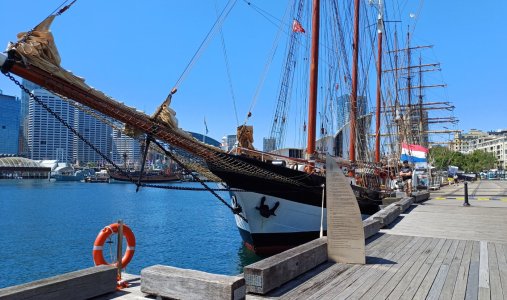
Trying to throw an experienced-mariner pose. It failed.
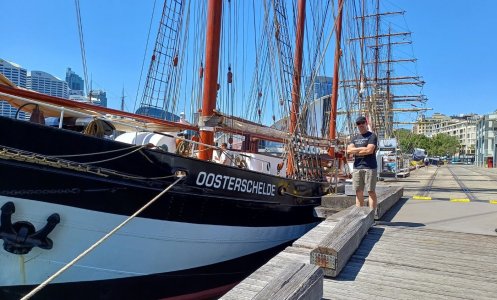
Seen behind the Oosterschelde is the James Craig, a three-masted, 19th century iron-hulled barque.
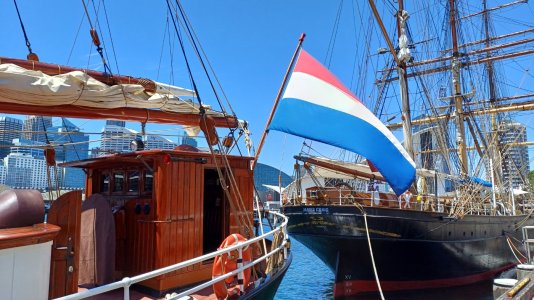
I desperately wanted to climb the ratlines and skirt along the footropes, but I was obliged to leave that to the real sailors.
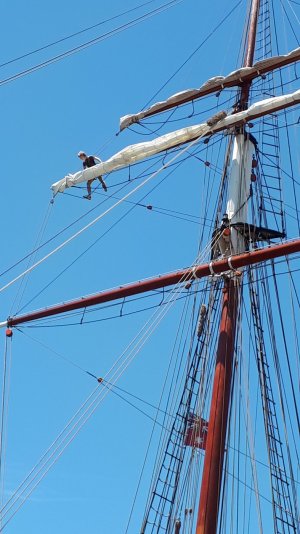
It helped that we had picture-perfect weather in Sydney for the occasion.
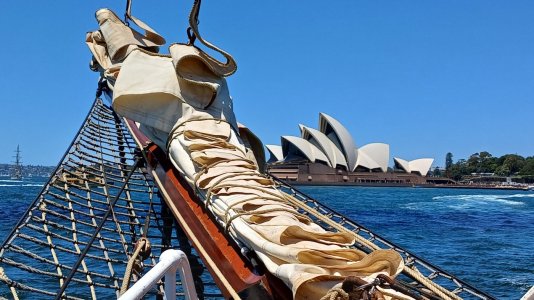
Study it as I might, I still could not work out how all the rigging worked. They did however allow me to help hoist three of the ship's sails, which was a lot harder than I thought it would be and I had to nurse an aching arm or two at the end of it all.
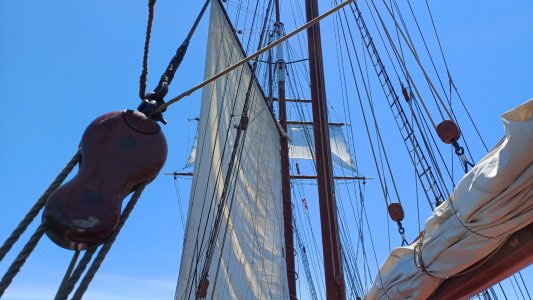
An inland breeze carried us along at about 4 - 5 knots apparently. Quite slow in comparison to all the other glitzy boats in the harbour, but none of them were nearly as impressive looking
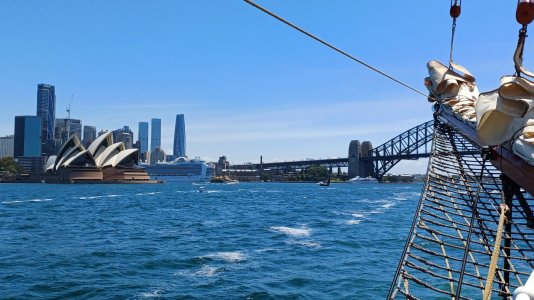
The Oosterschelde and James Craig cross paths. Take away the skyline, reduce the colour to black-and-white and we'd be right back in the 19th century.
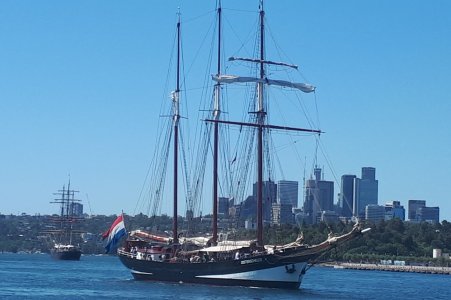
Returning to the point at which our cruise started, with the replica of the Endeavour at the far end of Darling Harbour.
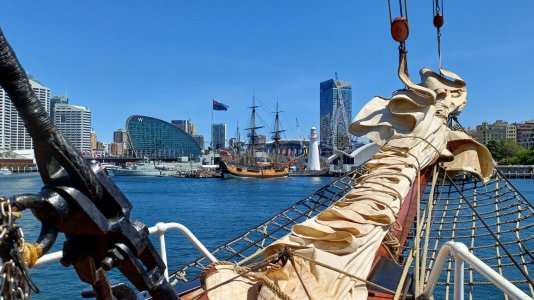
The Oosterschelde is something of a working ship, despite the touristy cruises they offer to supplement funds, and I spent a lot of time watching, in admiration, the crew who by force of habit knew exactly where to go and what to do. A most worthwhile experience

Thanks for checking in
Mark
I did however have a chance to sail on the Dutch tall ship Oosterschelde in Sydney Harbour this past weekend. It was a memorable experience and only cost me an outing to a musical with the Admiral the night before
For the history buffs the Oosterschelde is a three-masted schooner from the Netherlands, built in 1918, and currently on a cruise around the world. She is apparently the only remaining Dutch three-masted topsail schooner. Her home port is in Rotterdam.
I have attached a few pictures of my cruise in Sydney Harbour ...

Trying to throw an experienced-mariner pose. It failed.

Seen behind the Oosterschelde is the James Craig, a three-masted, 19th century iron-hulled barque.

I desperately wanted to climb the ratlines and skirt along the footropes, but I was obliged to leave that to the real sailors.

It helped that we had picture-perfect weather in Sydney for the occasion.

Study it as I might, I still could not work out how all the rigging worked. They did however allow me to help hoist three of the ship's sails, which was a lot harder than I thought it would be and I had to nurse an aching arm or two at the end of it all.

An inland breeze carried us along at about 4 - 5 knots apparently. Quite slow in comparison to all the other glitzy boats in the harbour, but none of them were nearly as impressive looking

The Oosterschelde and James Craig cross paths. Take away the skyline, reduce the colour to black-and-white and we'd be right back in the 19th century.

Returning to the point at which our cruise started, with the replica of the Endeavour at the far end of Darling Harbour.

The Oosterschelde is something of a working ship, despite the touristy cruises they offer to supplement funds, and I spent a lot of time watching, in admiration, the crew who by force of habit knew exactly where to go and what to do. A most worthwhile experience

Thanks for checking in
Mark
Last edited:
Wonderful pictures of a wonderful trip on a wonderful (Dutch) schooner, Mark. Thanks for sharing!.The HMS Fly shipyard has been in sad neglect over the past couple of months on account of numerous other unimportant things, but I do hope to get back on board as soon as possible.
I did however have a chance to sail on the Dutch tall ship Oosterschelde in Sydney Harbour this past weekend. It was a memorable experience and only cost me an outing to a musical with the Admiral the night before
For the history buffs the Oosterschelde is a three-masted schooner from the Netherlands, built in 1918, and currently on a cruise around the world. She is apparently the only remaining Dutch three-masted topsail schooner. Her home port is in Rotterdam.
I have attached a few pictures of my cruise in Sydney Harbour ...
View attachment 486487
Trying to throw an experienced-mariner pose. It failed.
View attachment 486488
Seen behind the Oosterschelde is the James Craig, a three-masted, 19th century iron-hulled barque.
View attachment 486489
I desperately wanted to climb the ratlines and skirt along the footropes, but I was obliged to leave that to the real sailors.
View attachment 486490
It helped that we had picture-perfect weather in Sydney for the occasion.
View attachment 486491
Study it as I might, I still could not work out how all the rigging worked. They did however allow me to help hoist three of the ship's sails, which was a lot harder than I thought it would be and I had to nurse an aching arm or two at the end of it all.
View attachment 486492
An inland breeze carried us along at about 4 - 5 knots apparently. Quite slow in comparison to all the other glitzy boats in the harbour, but none of them were nearly as impressive looking
View attachment 486493
The Oosterschelde and James Craig cross paths. Take away the skyline, reduce the colour to black and white, and we'd be right back in the 19th century.
View attachment 486494
Returning to the point at which our cruise started, with the replica of the Endeavour at the far end of Darling Harbour.
View attachment 486495
The Oosterschelde is something of a working ship, despite the touristy cruises they offer to supplement funds, and I spent a lot of time watching, in admiration, the crew who by force of habit knew exactly where to go and what to do. A most worthwhile experience
View attachment 486496
Thanks for checking in
Mark
Regards, Peter
- Joined
- Sep 23, 2021
- Messages
- 238
- Points
- 143

Super pictures Mark, The Oosterchelde is a really nice looking ship - what a great way to spend a day! Really like the James Craig, very similar hull lines to the Cutty Sark and they would have certainly been together when the Cutty Sark was sailing down to Australia on the wool runs.The HMS Fly shipyard has been in sad neglect over the past couple of months on account of numerous other unimportant things, but I do hope to get back on board as soon as possible.
I did however have a chance to sail on the Dutch tall ship Oosterschelde in Sydney Harbour this past weekend. It was a memorable experience and only cost me an outing to a musical with the Admiral the night before
For the history buffs the Oosterschelde is a three-masted schooner from the Netherlands, built in 1918, and currently on a cruise around the world. She is apparently the only remaining Dutch three-masted topsail schooner. Her home port is in Rotterdam.
I have attached a few pictures of my cruise in Sydney Harbour ...
View attachment 486487
Trying to throw an experienced-mariner pose. It failed.
View attachment 486488
Seen behind the Oosterschelde is the James Craig, a three-masted, 19th century iron-hulled barque.
View attachment 486489
I desperately wanted to climb the ratlines and skirt along the footropes, but I was obliged to leave that to the real sailors.
View attachment 486490
It helped that we had picture-perfect weather in Sydney for the occasion.
View attachment 486491
Study it as I might, I still could not work out how all the rigging worked. They did however allow me to help hoist three of the ship's sails, which was a lot harder than I thought it would be and I had to nurse an aching arm or two at the end of it all.
View attachment 486492
An inland breeze carried us along at about 4 - 5 knots apparently. Quite slow in comparison to all the other glitzy boats in the harbour, but none of them were nearly as impressive looking
View attachment 486493
The Oosterschelde and James Craig cross paths. Take away the skyline, reduce the colour to black and white, and we'd be right back in the 19th century.
View attachment 486494
Returning to the point at which our cruise started, with the replica of the Endeavour at the far end of Darling Harbour.
View attachment 486495
The Oosterschelde is something of a working ship, despite the touristy cruises they offer to supplement funds, and I spent a lot of time watching, in admiration, the crew who by force of habit knew exactly where to go and what to do. A most worthwhile experience
View attachment 486496
Thanks for checking in
Mark
Good morning Mark. I'm glad to see you are alive and kicking. I know the feeling, my Bounty has also been in the doldrums for the past few months. I thought that was a pic of you riding the horses out on the yard and then realised it is a youngster not a "toppie"The HMS Fly shipyard has been in sad neglect over the past couple of months on account of numerous other unimportant things, but I do hope to get back on board as soon as possible.
I did however have a chance to sail on the Dutch tall ship Oosterschelde in Sydney Harbour this past weekend. It was a memorable experience and only cost me an outing to a musical with the Admiral the night before
For the history buffs the Oosterschelde is a three-masted schooner from the Netherlands, built in 1918, and currently on a cruise around the world. She is apparently the only remaining Dutch three-masted topsail schooner. Her home port is in Rotterdam.
I have attached a few pictures of my cruise in Sydney Harbour ...
View attachment 486487
Trying to throw an experienced-mariner pose. It failed.
View attachment 486488
Seen behind the Oosterschelde is the James Craig, a three-masted, 19th century iron-hulled barque.
View attachment 486489
I desperately wanted to climb the ratlines and skirt along the footropes, but I was obliged to leave that to the real sailors.
View attachment 486490
It helped that we had picture-perfect weather in Sydney for the occasion.
View attachment 486491
Study it as I might, I still could not work out how all the rigging worked. They did however allow me to help hoist three of the ship's sails, which was a lot harder than I thought it would be and I had to nurse an aching arm or two at the end of it all.
View attachment 486492
An inland breeze carried us along at about 4 - 5 knots apparently. Quite slow in comparison to all the other glitzy boats in the harbour, but none of them were nearly as impressive looking
View attachment 486493
The Oosterschelde and James Craig cross paths. Take away the skyline, reduce the colour to black and white, and we'd be right back in the 19th century.
View attachment 486494
Returning to the point at which our cruise started, with the replica of the Endeavour at the far end of Darling Harbour.
View attachment 486495
The Oosterschelde is something of a working ship, despite the touristy cruises they offer to supplement funds, and I spent a lot of time watching, in admiration, the crew who by force of habit knew exactly where to go and what to do. A most worthwhile experience
View attachment 486496Good
Thanks for checking in
Mark
 . Cool trip and photos. Cheers Grant
. Cool trip and photos. Cheers GrantGreat Pictures Mark!The HMS Fly shipyard has been in sad neglect over the past couple of months on account of numerous other unimportant things, but I do hope to get back on board as soon as possible.
I did however have a chance to sail on the Dutch tall ship Oosterschelde in Sydney Harbour this past weekend. It was a memorable experience and only cost me an outing to a musical with the Admiral the night before
For the history buffs the Oosterschelde is a three-masted schooner from the Netherlands, built in 1918, and currently on a cruise around the world. She is apparently the only remaining Dutch three-masted topsail schooner. Her home port is in Rotterdam.
I have attached a few pictures of my cruise in Sydney Harbour ...
View attachment 486487
Trying to throw an experienced-mariner pose. It failed.
View attachment 486488
Seen behind the Oosterschelde is the James Craig, a three-masted, 19th century iron-hulled barque.
View attachment 486489
I desperately wanted to climb the ratlines and skirt along the footropes, but I was obliged to leave that to the real sailors.
View attachment 486490
It helped that we had picture-perfect weather in Sydney for the occasion.
View attachment 486491
Study it as I might, I still could not work out how all the rigging worked. They did however allow me to help hoist three of the ship's sails, which was a lot harder than I thought it would be and I had to nurse an aching arm or two at the end of it all.
View attachment 486492
An inland breeze carried us along at about 4 - 5 knots apparently. Quite slow in comparison to all the other glitzy boats in the harbour, but none of them were nearly as impressive looking
View attachment 486493
The Oosterschelde and James Craig cross paths. Take away the skyline, reduce the colour to black and white, and we'd be right back in the 19th century.
View attachment 486494
Returning to the point at which our cruise started, with the replica of the Endeavour at the far end of Darling Harbour.
View attachment 486495
The Oosterschelde is something of a working ship, despite the touristy cruises they offer to supplement funds, and I spent a lot of time watching, in admiration, the crew who by force of habit knew exactly where to go and what to do. A most worthwhile experience
View attachment 486496
Thanks for checking in
Mark
Good on you, mate! What a great experience!
Nice pics Mark!
- Joined
- Sep 3, 2021
- Messages
- 5,128
- Points
- 738

Can't say I'm not jealous...The HMS Fly shipyard has been in sad neglect over the past couple of months on account of numerous other unimportant things, but I do hope to get back on board as soon as possible.
I did however have a chance to sail on the Dutch tall ship Oosterschelde in Sydney Harbour this past weekend. It was a memorable experience and only cost me an outing to a musical with the Admiral the night before
For the history buffs the Oosterschelde is a three-masted schooner from the Netherlands, built in 1918, and currently on a cruise around the world. She is apparently the only remaining Dutch three-masted topsail schooner. Her home port is in Rotterdam.
I have attached a few pictures of my cruise in Sydney Harbour ...
View attachment 486487
Trying to throw an experienced-mariner pose. It failed.
View attachment 486488
Seen behind the Oosterschelde is the James Craig, a three-masted, 19th century iron-hulled barque.
View attachment 486489
I desperately wanted to climb the ratlines and skirt along the footropes, but I was obliged to leave that to the real sailors.
View attachment 486490
It helped that we had picture-perfect weather in Sydney for the occasion.
View attachment 486491
Study it as I might, I still could not work out how all the rigging worked. They did however allow me to help hoist three of the ship's sails, which was a lot harder than I thought it would be and I had to nurse an aching arm or two at the end of it all.
View attachment 486492
An inland breeze carried us along at about 4 - 5 knots apparently. Quite slow in comparison to all the other glitzy boats in the harbour, but none of them were nearly as impressive looking
View attachment 486493
The Oosterschelde and James Craig cross paths. Take away the skyline, reduce the colour to black-and-white and we'd be right back in the 19th century.
View attachment 486494
Returning to the point at which our cruise started, with the replica of the Endeavour at the far end of Darling Harbour.
View attachment 486495
The Oosterschelde is something of a working ship, despite the touristy cruises they offer to supplement funds, and I spent a lot of time watching, in admiration, the crew who by force of habit knew exactly where to go and what to do. A most worthwhile experience
View attachment 486496
Thanks for checking in
Mark
When I noticed barnacles forming under the hull of my much-neglected HMS Fly I knew that I'd been away from the shipyard too long, and I was relieved to pick up where I'd left off a couple of months ago and continue with the rigging of this fine vessel.
Of course, I thought that the completion of the hull was the starting point for all things rigging, and that I'd be laying all manner of lines and ropes that make up the cobweb of rigging on this ship, little thinking of all the numerous blocks that first need to be fitted to the yards and masts

Rigging the blocks to the yards and masts was reasonably straightforward. I discovered various techniques for fastening a block to a spar, most of which attempt to do two things: to minimise the size of the knot or seizing around the block so that it does not look ungainly, and to ensure that the block aligns appropriately with the rope to which it is seized.
The same applied to the footropes installed under the yards. The trick here being to give each footrope a reasonable amount of slack to make it look authentic, and to ensure that the same amount of slack is applied to each footrope on either side of the yard.
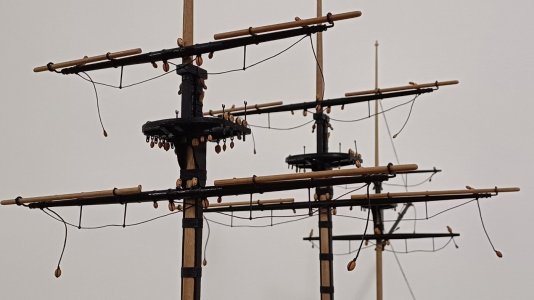
All of the masts and spars are still very loosely attached at this stage; one good shake and it'll look like a game of pick-up-sticks
Each yard has been fitted with a brass pin in the centre to connect it to its mast. This was done to confirm the arrangement and positioning of the yards, although I suspect they will become a permanent feature later on to provide stability during the rigging process.

Thanks for checking in
Mark
Of course, I thought that the completion of the hull was the starting point for all things rigging, and that I'd be laying all manner of lines and ropes that make up the cobweb of rigging on this ship, little thinking of all the numerous blocks that first need to be fitted to the yards and masts

Rigging the blocks to the yards and masts was reasonably straightforward. I discovered various techniques for fastening a block to a spar, most of which attempt to do two things: to minimise the size of the knot or seizing around the block so that it does not look ungainly, and to ensure that the block aligns appropriately with the rope to which it is seized.
The same applied to the footropes installed under the yards. The trick here being to give each footrope a reasonable amount of slack to make it look authentic, and to ensure that the same amount of slack is applied to each footrope on either side of the yard.

All of the masts and spars are still very loosely attached at this stage; one good shake and it'll look like a game of pick-up-sticks
Each yard has been fitted with a brass pin in the centre to connect it to its mast. This was done to confirm the arrangement and positioning of the yards, although I suspect they will become a permanent feature later on to provide stability during the rigging process.

Thanks for checking in
Mark
Hi NomadWhen I noticed barnacles forming under the hull of my much-neglected HMS Fly I knew that I'd been away from the shipyard too long, and I was relieved to pick up where I'd left off a couple of months ago and continue with the rigging of this fine vessel.
Of course, I thought that the completion of the hull was the starting point for all things rigging, and that I'd be laying all manner of lines and ropes that make up the cobweb of rigging on this ship, little thinking of all the numerous blocks that first need to be fitted to the yards and masts
View attachment 511015
Rigging the blocks to the yards and masts was reasonably straightforward. I discovered various techniques for fastening a block to a spar, most of which attempt to do two things: to minimise the size of the knot or seizing around the block so that it does not look ungainly, and to ensure that the block aligns appropriately with the rope to which it is seized.
The same applied to the footropes installed under the yards. The trick here being to give each footrope a reasonable amount of slack to make it look authentic, and to ensure that the same amount of slack is applied to each footrope on either side of the yard.
View attachment 511016
All of the masts and spars are still very loosely attached at this stage; one good shake and it'll look like a game of pick-up-sticks
Each yard has been fitted with a brass pin in the centre to connect it to its mast. This was done to confirm the arrangement and positioning of the yards, although I suspect they will become a permanent feature later on to provide stability during the rigging process.
View attachment 511017
Thanks for checking in
Mark
She looks very nice and is an excellent presentation of your patience and workmanship.I also started with the rigging of La Couronne therefore I studied your detailed photos but i couldn’t get rid of the question why you attached a dead eye instead a normal block to the yard ends on the bowspirit shown in attachment with an arrow. Amati model ia normal block attached
Regards


Good to see you back, Mark. Nice rigging and pictures with a great perspective!When I noticed barnacles forming under the hull of my much-neglected HMS Fly I knew that I'd been away from the shipyard too long, and I was relieved to pick up where I'd left off a couple of months ago and continue with the rigging of this fine vessel.
Of course, I thought that the completion of the hull was the starting point for all things rigging, and that I'd be laying all manner of lines and ropes that make up the cobweb of rigging on this ship, little thinking of all the numerous blocks that first need to be fitted to the yards and masts
View attachment 511015
Rigging the blocks to the yards and masts was reasonably straightforward. I discovered various techniques for fastening a block to a spar, most of which attempt to do two things: to minimise the size of the knot or seizing around the block so that it does not look ungainly, and to ensure that the block aligns appropriately with the rope to which it is seized.
The same applied to the footropes installed under the yards. The trick here being to give each footrope a reasonable amount of slack to make it look authentic, and to ensure that the same amount of slack is applied to each footrope on either side of the yard.
View attachment 511016
All of the masts and spars are still very loosely attached at this stage; one good shake and it'll look like a game of pick-up-sticks
Each yard has been fitted with a brass pin in the centre to connect it to its mast. This was done to confirm the arrangement and positioning of the yards, although I suspect they will become a permanent feature later on to provide stability during the rigging process.
View attachment 511017
Thanks for checking in
Mark
Regards, Peter
Hi Korsan,.... but i couldn’t get rid of the question why you attached a dead eye instead a normal block to the yard ends on the bowspirit shown in attachment with an arrow. Amati model ia normal block attached.
Wow great eyesight to pick that one up!
I re-checked my ship plans and sure enough, the instructions call for a deadeye at either end of the spritsail yard...

Mind you, there is a normal block next to the deadeye on either end of the yard as well, which is visible in the diagram above but not in the photo that I took. Perhaps the confusion lay there...
Cheers,
Mark
Looks great Mark and your photos really show off your excellent work. I’m hoping to get into pre-rigging soon so I’m presently heavy into reading various books. Can’t find much on attaching barnacles though  .
.
 .
.Assuming these are the standing lifts, they had deadeyes rigged at times, but they were not at the yard arm as in the drawing above. They were about a quarter of the way in from each yard arm according to James Lees' The Masting and Rigging of English Ships of War, page 100. In Steel's The Elements and Practice of Rigging and Seamanship page 196 he states the standing lift has an eye spliced in one end, and lashes to the yard one-fourth from the slings; the other end has a thimble spliced in, and is set up with a laniard to a thimble spliced in a strap that goes round the bowsprit within the bees. Whether you go with the deadeyes or thimbles, they would have been farther in from the yard arm than the drawing above if Lees and Steel are correct.
Allan
Allan
Hi AllanAssuming these are the standing lifts, they had deadeyes rigged at times, but they were not at the yard arm as in the drawing above. They were about a quarter of the way in from each yard arm according to James Lees' The Masting and Rigging of English Ships of War, page 100. In Steel's The Elements and Practice of Rigging and Seamanship page 196 he states the standing lift has an eye spliced in one end, and lashes to the yard one-fourth from the slings; the other end has a thimble spliced in, and is set up with a laniard to a thimble spliced in a strap that goes round the bowsprit within the bees. Whether you go with the deadeyes or thimbles, they would have been farther in from the yard arm than the drawing above if Lees and Steel are correct.
Allan
Is it possible to attach a picture of that mentioned assembly
Glad to see you back at it Mark.







